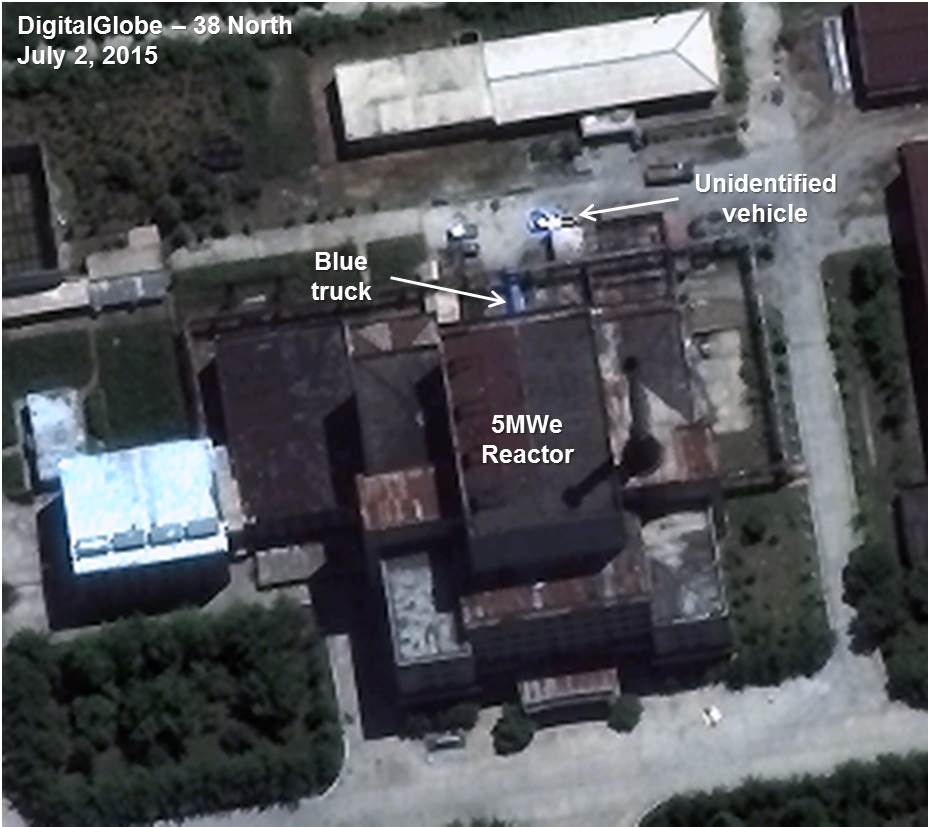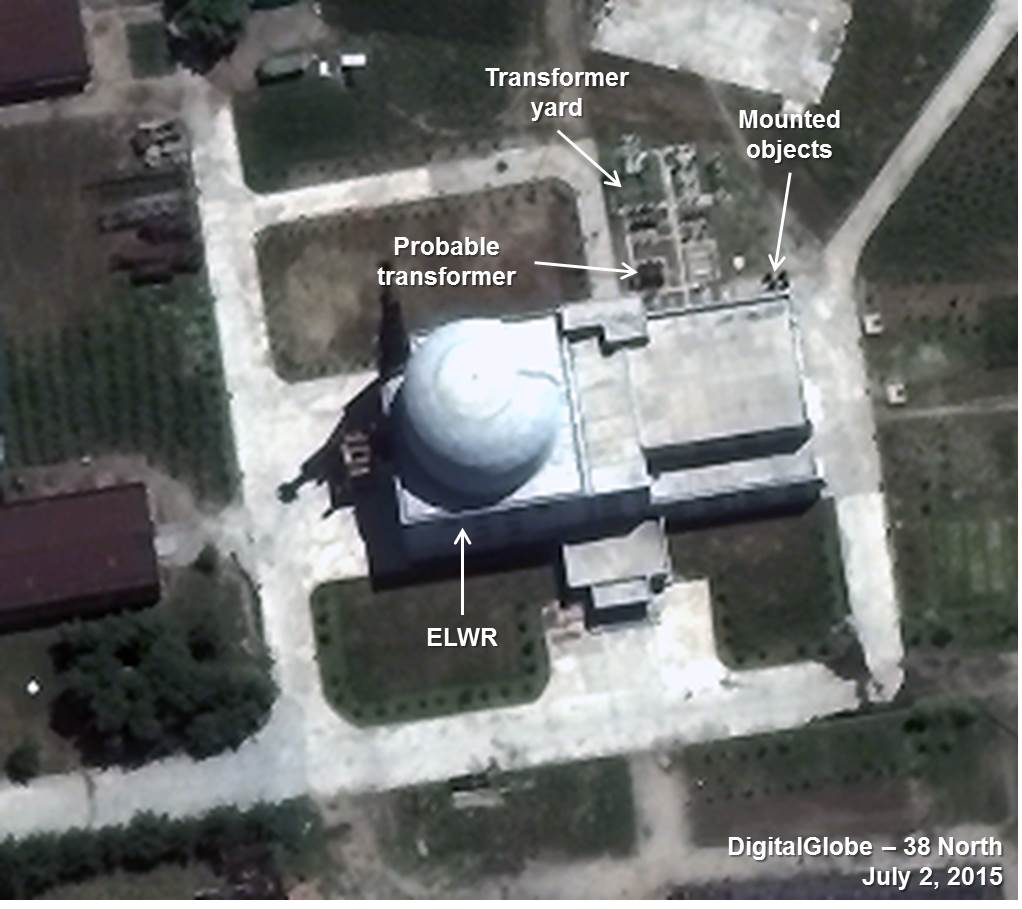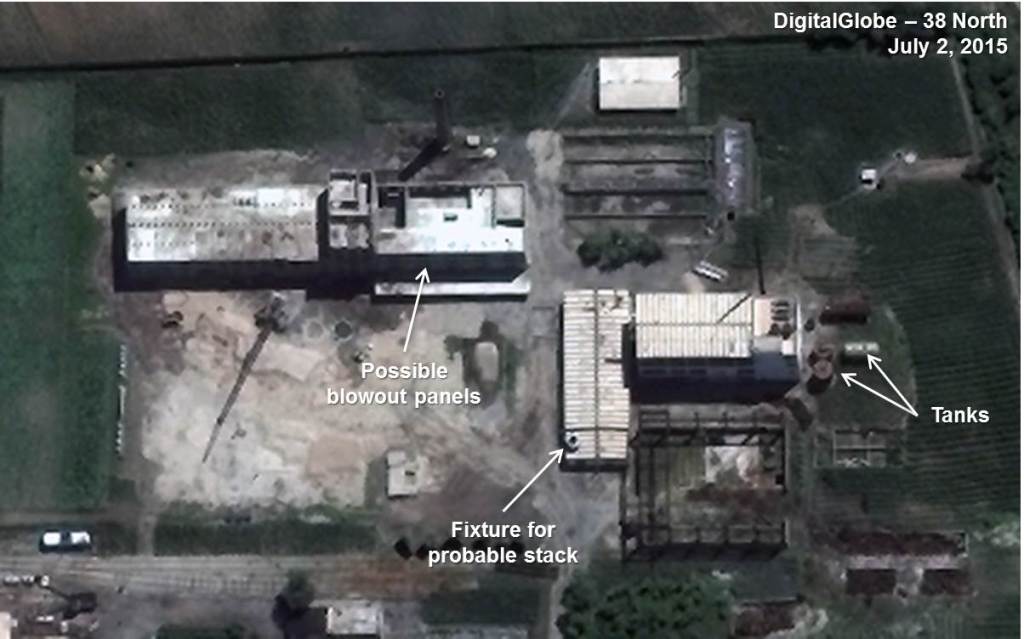North Korea’s Yongbyon Nuclear Facility: Sporadic Operations at the 5 MWe Reactor But Construction Elsewhere Moves Forward
A 38 North exclusive with analysis by William Mugford.
Summary
Recent commercial satellite imagery indicates that North Korea’s 5 MWe Plutonium Production Reactor may not be operating or is only functioning at low power levels. The presence of what is likely a vehicle to transport carbon dioxide used in the reactor’s cooling system may indicate that maintenance activities are underway. The reactor appears to have been operating only sporadically since fall 2014 perhaps because the facility is aging.
Construction that began in late spring 2015 continues at the incomplete Experimental Light Water Reactor (ELWR). Imagery from July 2 shows that the construction adjacent to the reactor hall can now be identified as a transformer yard to connect the electricity producing reactor to the grid. The yard appears to be complete but all the equipment is probably not yet installed. Once finished, the North Koreans will have taken another step towards beginning initial operation of the reactor.
Work also continued at a rapid pace at the Uranium Enrichment complex at Yongbyon. The roof of the building that contains the probable hot cells is nearly externally complete, as is the large unidentified L-shaped building.
5MWe Reactor Operations
Imagery from July 2, 2015, shows no evidence such as steam or hot water discharge that the 5 MWe Reactor is operating. There are at least five vehicles located along the road next to the rear access to the reactor hall. One blue truck with a square cab and a long trailer that is either a single tank or three vertical tanks is likely for transporting carbon dioxide used in the reactor cooling system. It has been observed at the facility before. This vehicle is backed up to the rear access door to the reactor hall, perhaps indicating that maintenance is underway. It is worth noting that the 5 MWe Reactor appears to have been operating only episodically, perhaps because of old age.
Figure 1. Vehicles at the 5 MWe Reactor.

Figure 2. Probable CO2 truck seen at the 5 MWe Reactor in April.

Construction at New ELWR Transformer Yard Finished
Imagery from July 2 indicates that the North Koreans have finished the initial construction of the transformer yard at the ELWR that will connect the electricity-producing reactor to the grid. The large mobile crane spotted in imagery from late May has now departed. The yard extends west from the southwest end of the reactor building and covers an area approximately 25 meters long and 18 meters wide. The access pathways to each equipment area are clearly defined, and probably made of concrete or white rock. While the yard appears to be complete, all the equipment probably has not been installed.
Of note is the presence of one large probable transformer encircled by access paths near the east end of the yard. This piece of equipment has been present since at least May, but may not have been mounted. There is another unidentified piece of power distribution equipment about 10 meters east of the large transformer, and at the southwest corner of the reactor building there are four dark objects that appear to be mounted on concrete foundations.
Figure 3. Transformer Yard at the ELWR.

Rapid Construction at the Uranium Enrichment Facility
Construction in the Uranium Enrichment Facility is proceeding rapidly. In the seven weeks since last imaged, the North Koreans have completed more than 75 percent of the roof of a large new building. Previous analysis identified what appeared to be five probable hot cells for handling nuclear material in the building. That conclusion was consistent with their shape and the fact that the cells have a typically large foundation.
Nevertheless, the July 2 imagery showing the east facing outside wall of the cells at least raises the possibility that these cells may instead be used to assemble or store conventional high explosive components of a nuclear weapon. The wall’s five evenly spaced panels that are a different tone and texture than the rest of the wall are probably a decorative or imagery anomaly. However, if there is a difference in the construction of the outside walls of the cells, they could be blow-out panels. Found on high explosive (HE) assembly and storage buildings to reduce the level of damage if an HE assembly explodes during assembly or storage, a blow-out panel directs most of the energy outside the structure, so adjacent cells are not damaged. The energy directed outside is deflected upward by a surrounding earthen berm.
A key consideration will be whether the North Koreans construct such a berm around the area intended to deflect the explosion. Whether that is possible remains unclear since the rear of the building is very close to the adjacent L-shaped structure, leaving little room for a berm.
The L-shaped building has a fixture for a probable stack on the eastern end of the roof, indicating an operational structure. There are also two cylindrical mounted tanks outside the south end of the building, and a third tank on the ground, perhaps to be placed inside the structure. The stack and tanks are clues to the purpose of this building, but not sufficient to identify how it will be used.
Figure 4. Construction at the Uranium Enrichment Facility.

